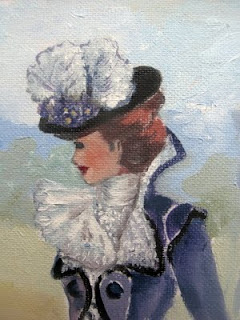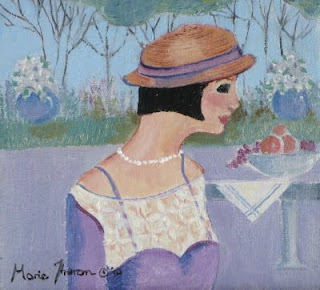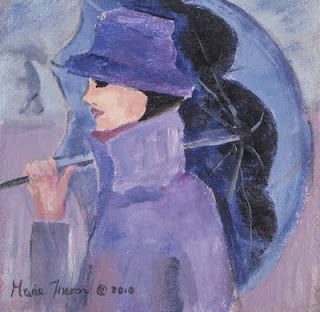


Among the very affluent classes in Edwardian times, fresh cut flowers was brought indoors to decorate each room of the house. "Mrs Beeton's Book of Household Management" (1906) declared that they added a touch of refinement on the dinner table. Pretty potted parma violets,
the chosen flower of the period, could even be used to decorate the breakfast table. After reading my blog (and commenting if you please), look at the delightful
Lady with a Bowl of Violets (1910) by Lilla Cabot Perry.
On ladies' clothing former "artificials" would now compete with real roses and carnations. Parma violets, with their lovely scent, appeared as hat, hip, pulse or neck decorations. The shade of these pretty flowers entered fashion in amazing ways! I read about the outfit for an Edwardian bride: "corsets, perhaps in a delicate parma violet shade, could be enticingly pretty"! So here is my oil painting showing a long frock-type walking dress with a swivel hemline in that colour, with matching hat.
I should point out that a ladies' maid had much to do with the completed look of the lady of leisure. She had to be very skilled with hair and with tying in and corsetting the waist. It would take her at least an hour to sew the brush braid (cleaned and laundered) into the hemline of her lady 's dress to catch the mud and dirt (Nowwww, we know!!!)
In 3 previous posts I have summarized the characteristics of Edwardian fashion. So here are more points to take note of:
- The skirts of dresses were narrow and flat-fronted and ended in floor-dragging swivel hemlines that had to protected by the two- and- a-half yard brush braid, sewn on before venturing out.
- Many Edwardian hats were tilted forward to show all that lovely piled hair in the back.
- Hat decorations were elaborate and could feature artificial of fresh flowers and dyed ostrich feathers.
- A very lacy jabot with scarf-like frills was a single piece that could be worn with different outfits. Flower and ribbon posies, jabots and boned collars were called "novelties" in the shops.
- I mentioned before that the S-shaped stance was not very comfortable. Ladies would lean on umbrellas and in my painting she has a long delicate walking stick.
And of course, the aim of today's painting: another trait to take note of! A new colour was born in Edwardian times: parma violet. The photo of the real flower is published with kind permission of the photographer, the rest of the collage shows images of violets from various Victorian cards. I am running away from the main topic here, but it is interesting to read the research done by The American Violet Society about
violets in art.














